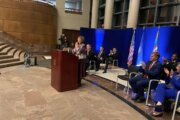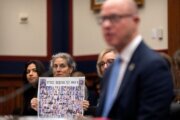SILVER SPRING, Md. — Attorney General Doug Gansler, who plans to run for Governor in 2014, tells WTOP his vision for the future of Maryland transportation includes a shift away from road projects and toward an emphasis on mass transit.
“The first thing we have to look at on our existing highways is infrastructure – making sure it’s not crumbling, the bridges are staying up. In terms of new roads, new highways or adding lanes, other than small projects, I don’t think there is huge appetite right now for ICC-like projects,” he says.
“There clearly needs to be a preference for public transportation because the more public transportation, the fewer cars you’ll have on the road and the less need you’ll have for more lanes or new highways.”
Gansler spoke before the Montgomery County Action Committee for Transit, touting projects like the Purple Line and the Corridor Cities Transitway as top transportation priorities.
“We have almost two million people living in Montgomery County and Prince George’s County, we have no public transportation going east-west at this point. We do have the ICC, we do have the Beltway, but we need a public transportation source. So the Purple Line fulfills that role and fills that vacuum,” says Gansler.
Gov. Martin O’Malley recently announced $400 million toward the Purple Line for construction, along with $280 million for final design and right-of-way acquisition for land. While the commitment remains short of the necessary contribution, it puts Maryland in a good position to make a case for federal funding.
The 16-mile light rail project from Bethesda to New Carrollton will ultimately cost $2.15 billion and require state, federal and private dollars.
Lt. Gov. Anthony Brown and Transportation Secretary Jim Smith are playing active roles in lobbying both the Federal Transit Administration and private companies to fund their project. Private money would come through the Public-Private Partnership Act, which Brown helped spearhead through the General Assembly this past session.
Brown and Gansler will likely be the top contenders in the Governor’s race as it heats up in 2014.
“Public-private partnerships are wonderful things in principle. The question is in the detail. What responsibilities are the government abdicating? What is the funding source? Is it a fair funding source? We have to have public oversight of any public-private partnership. The government has to make sure they don’t take advantage of the consumers,” says Gansler.
The Corridor Cities Transitway is another example of a project that could be a candidate for a public-private partnership. CCT is a bus-rapid transit system that would run in bus-only lanes.
“Anyone who’s driven up and down 270 any hour of the day, much less rush hour, understands the need for the Corridor Cities Transitway. From Bethesda all the way up to Frederick, there really is no public transportation. It stops at Shady Grove. We need to able to extend that out, so that people coming from Gaithersburg, Germantown and other far-reaching areas aren’t sitting there breathing in smoke on 270 during the day and night,” says Gansler.
Phase one would be a nine-mile route connecting the Shady Grove Metro Station to the Metropolitan Grove MARC Station in Gaithersburg. Phase two would extend it five miles from Metropolitan Grove to COMSAT in Clarksburg.
But only phase one is being designed right now and not much movement has taken place on phase two. Gov. O’Malley dedicated $100 million toward final design of phase one and even Gansler suggests a wait-and-see attitude on phase two.
Another option that could improve traffic along I-270, the Capital Beltway and I- 95 is better train service between Baltimore and Washington, D.C. Gansler suggests exploring high-speed rail between the two cities and improvements to MARC service.
“The MARC train is the most obvious and least expensive (way), to make that more efficient and more effective,” says Gansler. “More weekend service, more regular service during the week and making sure it’s more reliable and modernized.”
In May, the Maryland Transit Administration announced a deal with Amtrak to unveil some weekend trains on the Penn Line likely before the end of 2013. The MTA also announced enhanced weekday service on the Camden Line.
One major hurdle to evening and weekend service on the Camden and Brunswick Lines is that CSX owns the tracks, rather than Amtrak. The MTA introduced a “MARC Growth and Reinvestment Plan” in 2007 to provide such services, but it would require a massive infusion of cash and new infrastructure and likely take until 2035 to finish.
It remains unclear whether the next Maryland Governor, whether it’s Brown, Gansler, Heather Mizeur or a Republican candidate, would be willing to spend the money necessary to fulfill the plan.
Gansler does believe some transportation dollars from the new gas tax could go toward the Washington Metro Area Transit Authority. He told the Action Committee for Transit that it would be worth discussing whether Maryland should provide WMATA with a dedicated source of funding.
Gansler also floated the idea of discussing a Metro line to connect Huntington to the National Harbor to handle the extra traffic that a new casino could generate across the region.
Follow @WTOP on Twitter.






